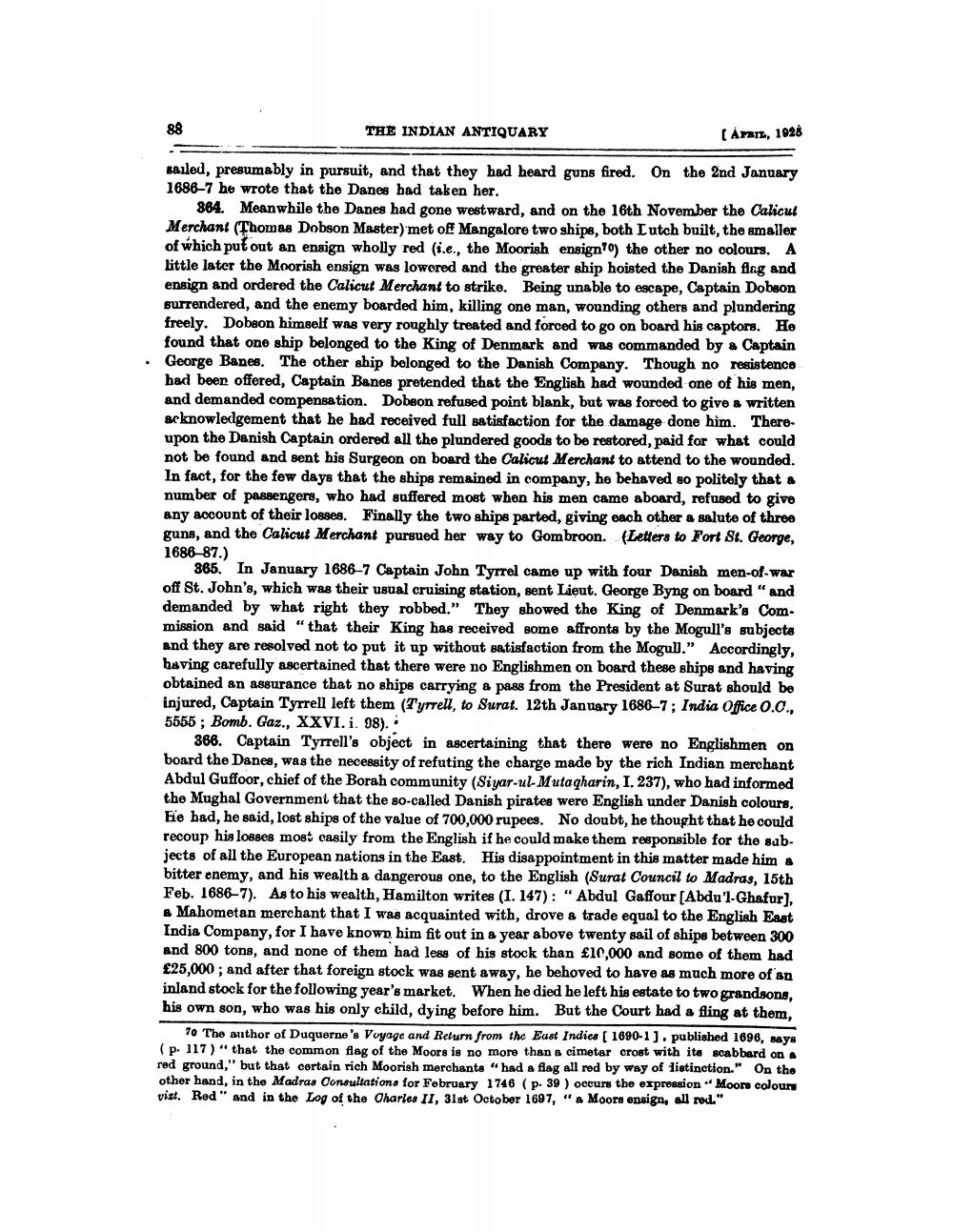________________
88
THE INDIAN ANTIQUARY
(Aran, 1928
Bailed, presumably in pursuit, and that they had heard guns fired. On the 2nd January 1686-7 he wrote that the Danes bad taken her.
864. Meanwhile the Danes had gone westward, and on the 16th November the Calicut Merchant (Thomas Dobson Master) met of Mangalore two ships, both Lutch built, the smaller of which put out an ensign wholly red (i.e., the Moorish ensigno) the other no colours. A little later the Moorish ensign was lowered and the greater ship hoisted the Danish flag and ensign and ordered the Calicut Merchant to strike. Being unable to escape, Captain Dobson surrendered, and the enemy boarded him, killing one man, wounding others and plundering freely. Dobson himself was very roughly treated and forced to go on board his captors. He found that one ship belonged to the King of Denmark and was commanded by a Captain George Banes. The other ship belonged to the Danish Company. Though no resistenco had been offered, Captain Banes pretended that the English had wounded one of his men, and demanded compensation. Dobson refused point blank, but was forced to give & written acknowledgement that he had received full satisfaction for the damage done him. Thereupon the Danish Captain ordered all the plundered goods to be restored, paid for what could not be found and sent his Surgeon on board the Calicut Merchant to attend to the wounded. In fact, for the fow days that the ships remained in company, he behaved 80 politely that a number of passengers, who had suffered most when his men came aboard, refused to give any account of their losses. Finally the two ships partod, giving each other a salute of three guns, and the Calicut Merchant pursued her way to Gombroon. (Letters to Fort St. George, 1686-87.)
865. In January 1686-7 Captain John Tyrrel came up with four Danish men-of-war off St. John's, which was their usual cruising station, sent Lieut. George Byng on board" and demanded by what right they robbed." They showed the King of Denmark's Commission and said "that their King has received some affronts by the Mogull's subjects and they are resolved not to put it up without satisfaction from the Mogull." Accordingly, having carefully ascertained that there were no Englishmen on board these ships and having obtained an assurance that no ships carrying a pass from the President at Surat should be injured, Captain Tyrrell left them (Tyrrell, to Surat. 12th January 1686–7; India Office 0.0., 5555; Bomb. Gaz., XXVI. i. 98).
366. Captain Tyrrell's object in ascertaining that there were no Englishmen on board the Danes, was the necessity of refuting the charge made by the rich Indian merchant Abdul Guffoor, chief of the Borah community (Siyar-ul-Mutaqharin, I. 237), who had informed the Mughal Government that the so-called Danish pirates were English under Danish colours, hie had, he said, lost ships of the value of 700,000 rupees. No doubt, he thought that he could recoup his losses most casily from the English if he could make them responsible for the subjects of all the European nations in the East. His disappointment in this matter made him a bitter enemy, and his wealth a dangerous one, to the English (Surat Council to Madras, 15th Feb. 1686-7). As to his wealth, Hamilton writes (I. 147): "Abdul Gaffour (Abdu'l-Ghafur), # Mahometan merchant that I was acquainted with, drove a trade equal to the English East India Company, for I have known him fit out in a year above twenty sail of ships between 300 and 800 tons, and none of them had less of his stock than £10,000 and some of them had £25,000; and after that foreign stock was sent away, he behoved to have as much more of an inland stock for the following year's market. When he died he left his estate to two grandsons, his own son, who was his only child, dying before him. But the Court had a fling at them,
70 The author of Duquerne's Voyage and Return from the East Indies ( 1690-1). published 1698, says (p. 117) " that the common flag of the Moore is no more than a cimeter crost with its scabbard on red ground," but that certain rich Moorish merchanta "had a flag all red by way of listinction." On the other hand, in the Madras Consultations for February 1746 (p. 39 ) occurs the expression Moons colours vist. Red" and in the Log of the Charles II, 31st October 1697, "a Moors ensign, all rod."




